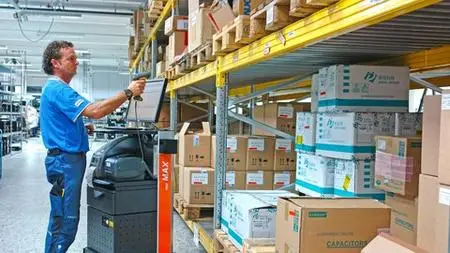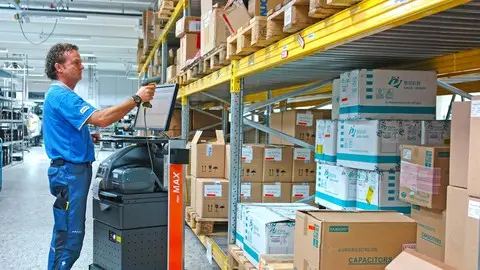Warehouse & Inventory Management
Published 8/2023
MP4 | Video: h264, 1280x720 | Audio: AAC, 44.1 KHz
Language: English | Size: 4.30 GB | Duration: 3h 30m
Published 8/2023
MP4 | Video: h264, 1280x720 | Audio: AAC, 44.1 KHz
Language: English | Size: 4.30 GB | Duration: 3h 30m
The traditional role of a warehouse is to provide storage on a temporary basis for a number of reasons.
What you'll learn
covering the role, Objective & value of a warehouse with it’s different types And what are the different functions of Inventory stored in the warehouse
This new role for the warehouse of handling the reverse logistics provides flexibility to those managing the supply chain.
Improved Inventory Accuracy
Increased Efficiency and Productivity
Cost Reduction
Enhanced Customer Service
Risk Mitigation
Requirements
Basic Knowledge of Supply Chain Management
some courses may require prior experience or education in related fields such as logistics, operations management, or business administration.
Description
The traditional role of a warehouse is to provide storage on a temporary basis for a number of reasons. it's also used as a place for returned goods handling, disassembling returned items, reconditioning, and repackaging. we shall get into more details and values of it.The Warehouse and Inventory Management course provides participants with the knowledge and skills necessary to effectively manage warehouse operations and optimize inventory control. This course covers various aspects of warehouse management, including inventory accuracy, efficiency, cost reduction, customer service, and risk mitigation.Throughout the course, participants learn techniques to improve inventory accuracy, such as cycle counting and ABC analysis, which help minimize errors and discrepancies. They also explore strategies for optimizing warehouse layouts, implementing efficient picking and packing methods, and utilizing technology solutions like barcode scanning and warehouse management systems (WMS) to enhance productivity and reduce manual errors.Cost reduction is another focus of the course, with participants gaining insights into demand forecasting, order optimization, and supplier management. By accurately predicting demand, optimizing order quantities, and effectively managing suppliers, businesses can minimize carrying costs, stock obsolescence, and overall operational expenses.Enhancing customer service is a key outcome of the course. Participants learn about order prioritization, cross-docking, and fulfillment strategies that ensure products are available when customers need them, reducing lead times and improving order fulfillment rates. This emphasis on customer satisfaction and loyalty can contribute to the overall success of a business.Lastly, the course covers risk mitigation strategies, equipping participants with the tools to identify and manage risks such as stock obsolescence, theft, damage, and supply chain disruptions. By implementing effective risk management techniques, businesses can minimize financial losses, maintain inventory integrity, and ensure continuity of operations even in challenging circumstances.Overall, the Warehouse and Inventory Management course provides participants with a comprehensive understanding of warehouse operations and inventory control. By acquiring these skills, individuals can contribute to the success and profitability of businesses by optimizing inventory, improving operational efficiency, reducing costs, enhancing customer service, and mitigating risks.
Overview
Section 1: Warehousing Fundamentals
Lecture 1 What is a warehouse
Lecture 2 Warehouse as an Essential Supply Chain Element
Lecture 3 The Value of Warehousing
Lecture 4 The traditional role of a Warehouse
Lecture 5 Role of the warehouse in the supply chain ( Part 1 )
Lecture 6 Role of the warehouse in the supply chain ( Part 2 )
Lecture 7 Why warehouse management is challenging
Lecture 8 Objectives of Warehousing
Lecture 9 Types of Warehouses
Section 2: Inventory Management Objectives & Types
Lecture 10 Inventory Management Objectives - Part 1
Lecture 11 Inventory Management Objectives - Part 2
Lecture 12 Inventory Management Objectives - Part 3
Lecture 13 Types & Functions of Inventory ( Part 1 )
Lecture 14 Types of Inventory - Part 2
Lecture 15 Types of Inventory - Part 3
Lecture 16 Inventory costs ( Part 1 )
Lecture 17 Inventory costs ( Part 2 )
Section 3: Financial Statement & Inventory
Lecture 18 Balance Sheet - Part 1
Lecture 19 Balance Sheet - Part 2
Lecture 20 Balance Sheet - Part 3
Lecture 21 Income Statement - Part 1
Lecture 22 Income Statement - Part 2
Lecture 23 Statement of Cash Flow - Part 1
Lecture 24 Statement of Cash Flow - Part 2
Lecture 25 Average Inventory & Inventory Turnover
Lecture 26 Days of Supply
Lecture 27 Safety lead time
Section 4: Inventory Policies and Controls
Lecture 28 Inventory Policies & control
Lecture 29 ABC Inventory Control
Lecture 30 Order Quantities - Part 1
Lecture 31 Order Quantities - Part 2
Lecture 32 Order Quantities - Part 3
Lecture 33 Supply Chain Inventory Strategies - Part 1
Lecture 34 Supply Chain Inventory Strategies - Part 2
Warehouse Managers,Business Owners,Entrepreneurs



